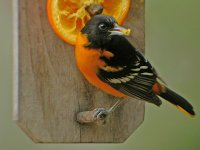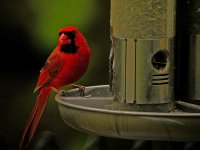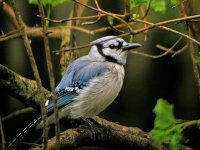This forum is simply essential to anyone interested in learning the basics of digiscoping. I joined before purchasing any equipment. Using the input from so many knowledgeable people I was able to assemble an outfit that has the potential to produce really great images, that is, once I truly understand the concepts and can implement them effectively. The attached thumbnails illustrate my first attempts.
The photos were taken using a Nikon 4500, Zeiss ST DiaScope T*FL 85mm w/20-60X ocular and Cheang UDA (MUDA)CLA adapter & mechanical shutter release. The digiscoping unit is attached to a Bogen/Manfrotto Tripod- #3021BN with the Micro fluid, Quick Release panning Head- #3130.
The Cheang adapter is really outstanding, beautiful workmanship- it immediately solved my first problem of coupling the camera to the scope- Mr Cheang was extremely helpful and immediately answered all my inquiries. Once my bank solved all its transfer problems I received the adapter & all parts within 6 days after Mr Cheang received the funds. All transfer delays originated with my bank not his instructions or his bank.
The major problem I have is the most common- obtaining a sharp image. The images were taken with the camera set- Aperature priority, AF-S ISO-100, Fine (2272x1704) & macro (yellow flower)
All photos were under-exposed- The cardinal was extremely under-exposed (used Photo Elements v3 to lighten the background which resulted in very serious distortion). Applying the unsharp mask only enhanced the distortion.
I am trying to use Manual focus and the scope to focus the image but the image on the monitor is difficult to see. When I invoke Manual mode the macro to infinity bar is solid and does not change as I focus the scope. Should this bar change as I bring the image into and out of focus? I assume the purpose of this bar is to indicate the focus range and that it will change color or give some other indication if the focusing ability of the camera is out of range. Is my assumption correct.
Any suggestions will be most appreciated.
The photos were taken using a Nikon 4500, Zeiss ST DiaScope T*FL 85mm w/20-60X ocular and Cheang UDA (MUDA)CLA adapter & mechanical shutter release. The digiscoping unit is attached to a Bogen/Manfrotto Tripod- #3021BN with the Micro fluid, Quick Release panning Head- #3130.
The Cheang adapter is really outstanding, beautiful workmanship- it immediately solved my first problem of coupling the camera to the scope- Mr Cheang was extremely helpful and immediately answered all my inquiries. Once my bank solved all its transfer problems I received the adapter & all parts within 6 days after Mr Cheang received the funds. All transfer delays originated with my bank not his instructions or his bank.
The major problem I have is the most common- obtaining a sharp image. The images were taken with the camera set- Aperature priority, AF-S ISO-100, Fine (2272x1704) & macro (yellow flower)
All photos were under-exposed- The cardinal was extremely under-exposed (used Photo Elements v3 to lighten the background which resulted in very serious distortion). Applying the unsharp mask only enhanced the distortion.
I am trying to use Manual focus and the scope to focus the image but the image on the monitor is difficult to see. When I invoke Manual mode the macro to infinity bar is solid and does not change as I focus the scope. Should this bar change as I bring the image into and out of focus? I assume the purpose of this bar is to indicate the focus range and that it will change color or give some other indication if the focusing ability of the camera is out of range. Is my assumption correct.
Any suggestions will be most appreciated.






